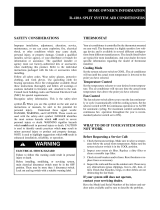
2
ABOUT THE HEAT PUMP
Your heat pump is a unique, all weather comfort-control
appliance that will heat and cool your home year round and
provide energy saving comfort. It’s often not recognized
that heat is always in the air, even when the outside
temperature is below freezing. The heat pump uses
this basic fact of physics to provide energy saving heat
during the winter months. For example, If the outdoor
temperature is 47° F (8° C), your heat pump can deliver
approximately 3.5 units of heat energy per each unit of
electrical energy used, as compared to a maximum of
only 1 unit of heat energy produced with conventional
electric heating systems.
In colder temperatures, the heat pump performs like an air
conditioner run in reverse. Available heat energy outside
the home is absorbed by the refrigerant and released
inside the home. This efficient process means you only
pay for “moving” the heat from the outdoors to the indoor
area. You do not pay to generate the heat, as with more
traditional means of heating.
During summer, the heat pump reverses the flow of the
heat-absorbing refrigerant to become an energy-efficient,
central air conditioner. Excess heat energy inside the
home is absorbed by the refrigerant and released outside
the home.
OPERATING INSTRUCTIONS
Thermostat styles vary. Please refer to the thermostat
manufacturer’s User manual for detailed programming
instructions.
Cooling Operation Only
1. Set the thermostat’s system mode to COOL and change
the fan mode to AUTO.
2. Set the temperature selector to the desired temperature
level. The outdoor fan, compressor, and blower motor will
all cycle on and off to maintain the indoor temperature
at the desired cooling level.
NOTE: If the temperature level is re-adjusted, or the
system mode is reset, the fan and compressor in the
outdoor unit may not start immediately. A protective
timer circuit holds the compressor and the outdoor
fan off for typically 3 to 5 minutes following a previous
operation or the interruption of the main electrical power
before restarting.
3. When the difference between temperature setpoint
and actual room temperature is relatively small, the
unit will operate at stage 1 and a lower indoor blower
air flow rate is used. When that temperature difference
is higher than some value (determined by the specific
themostat used), the unit will operate at Stage 2, and a
higher air flow rate will be used. The outdoor equiment
will operate at one or more different speeds in each of
these stages, depending on the heat pump model.
Heating Operation Only
1. Set the thermostat’s system mode to HEAT and change
the fan mode to AUTO.
2. Set the temperature selector to the desired temperature
level. The compressor, outdoor fan, and blower motor
will cycle on and off to maintain the indoor temperature
at the desired heating level.
NOTE: If the temperature level is re-adjusted, or the
system mode is reset, the fan and compressor in the
outdoor unit may not start immediately. A protective
timer circuit holds the compressor and the outdoor
fan off for typically 3 to 5 minutes following a previous
operation or the interruption of the main electrical power
before restarting.
3. When the difference between temperature setpoint
and actual room temperature is relatively small, the
unit will operate at stage 1 and a lower indoor blower
air flow rate is used. When that temperature difference
is higher than some value (determined by the specific
themostat used), the unit will operate at Stage 2, and a
higher air flow rate will be used. The outdoor equiment
will operate at one or more different speeds in each of
these stages, depending on the heat pump model.
Emergency Heat
Many thermostats include a system operating mode called
Emergency Heat (abbreviated EM HT or AUX HT, etc). In
this mode, heating is provided solely by the backup means
(electric strip heat or gas furnace), and the heat pump
is not used. This may typically be selected by the user
when there is a problem with the heat pump equipment,
when the outdoor temperature is too low for heat pump
operation, or for any other reason or preference. Some
thermostats automatically revert to backup heating means
under certain conditions. Refer to the thermostat manual.
The user is advised to avoid using Emergency Heat except
under exceptional circumstances, since the energy costs
are likely to be significantly higher than with the heat pump
Defrost Operation
During cold weather heat pump operation, the outdoor unit
will develop a coating of snow and ice on the heat transfer
coil. This is normal and the unit will defrost itself. This unit
features Demand Defrost that monitors ambient and coil
temperatures to regulate the defrost function accordingly.
At the beginning of the defrost cycle, both the outdoor
condenser fan and compressor will turn off. After a brief
delay, the compressor will turn on and begin to heat the
outdoor coil causing the ice and snow to melt. NOTE:
While the ice and snow is melting, some steam may rise
from the outdoor unit as the warm coil causes the melting
frost to evaporate. When defrost is completed, the outdoor
fan motor will start, and the compressor will turn off again.
After a brief delay, the compressor will start up again and
continue normal operation.




